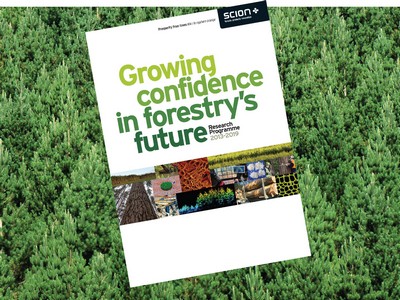Doubling forest productivity sustainably
The programme is a joint initiative between Scion, the forest growing industry and the Ministry of Business, Innovation and Employment that will combine world leading technology with an in-depth knowledge of plant growth sciences to improve the value of forestry through sustainable intensification.
The Ministry has allocated $3.375 million a year funding to the project with a further $1.6 million a year commitment from forest growers.
“This is one of the most significant initiatives undertaken by the sector,” says Russell Dale, recently appointed Research and Development Manager for the New Zealand Forest Owners’ Association. “It is focused on improving the value of existing forests and doubling the productivity of future forests. The forestry industry has a target of increasing the value of New Zealand’s forest exports to $12 billion by 2022. This requires a major investment in new and upgraded processing facilities that will only be possible if processors can be assured of a stable wood supply.

'Growing confidence in forestry's future' is aimed at raising the profitability of commercial forestry.
“Other land users strive to improve the value of products produced from each hectare of land through intensification. The forest industry must do likewise in order to remain competitive. Furthermore, this intensification must be within environmental limits to ensure our access to international wood markets is protected and that forests continue to make positive contributions through delivery of a variety of ecosystem services such as the improvement of water quality.”
Doubling productivity will require precision forestry, integrating the latest advances in sensor technology, tree physiology, genetics and forest ecology, and vitally, working closely with industry to solve problems. The research programme targets where improvements can be made throughout the forest growing cycle for both current and future forests that will boost productivity under intensified management regimes, while maintaining wood quality and the quality of the environment.
“The forests that will provide timber and wood fibre for the next 15 years are already growing,” says Scion Science Leader Dr Peter Clinton. “We are therefore targeting mid-rotation treatments to increase tree growth and considering options to realise more value from the logs harvested, while learning more about these trees in order to create better forests in the future.”
“We are building on our current understanding of tree growth and wood formation. We need to gain a better understanding of how fundamental processes within individual trees (genotypes) and the overall ecosystem are influenced when we add, for example, water, fertiliser or a bio-stimulant. This level of knowledge is required to optimise the match between tree genetics, management practices and environmental conditions, and to guard against unintended consequences.” The programme involves many layers of research, central to which will be the development of a forest ‘phenotyping platform’ capable of providing information about the ‘in the forest’ performance of different genetic material under a range of environmental conditions. These data will enable superior trees, such as those with improved disease resistance and more uniform wood quality, to be identified for breeding programmes.
The programme involves many layers of research, central to which will be the development of a forest ‘phenotyping platform’ capable of providing information about the ‘in the forest’ performance of different genetic material under a range of environmental conditions. These data will enable superior trees, such as those with improved disease resistance and more uniform wood quality, to be identified for breeding programmes.
“Doubling productivity is an ambitious goal and one that requires significant new research to achieve,” says Peter. “However, it’s important to understand what the effects of intensification may be on the subsequent planting of sites. Responsible stewardship of soil and water quality, biodiversity and recreation opportunities is critical to the forest industry’s licence to operate. Our access to international wood markets depends on this.”
Collaborators include Landcare Research, University of Auckland, Waiariki Institute of Technology, University of Canterbury, Oregon State University, Université Laval and CSIRO.
For further information:
Contact Dr Peter Clinton at Show email
